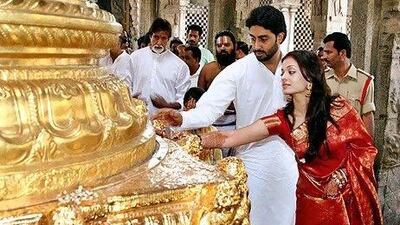The increasing price of gold has influenced investment strategies all over the world. The increases have become so steep that they have hit savings plans designed for other realms as well.
Donations of the precious metal to the Hindu deity Lord Venkateswara have dropped of late after the price of gold staged a big rally in the past six months.
The country's holy sites traditionally burst at the seams with money, gold and jewellery as hundreds of thousands of devotees bring in riches worth millions of dollars every year as offerings to the gods.
But many temples say there is less gold coming in now as the 11 per cent increase in prices has persuaded people to hang on to the metal and donate cash instead.
Tirupati temple, the second-largest holy site in India, said gold offerings had declined.
"Traditionally the temple gets around 80kg of gold every month," said Bhaskara Reddy, the financial officer of Tirumala Tirupati Devasthanam Trust. "But in the last six months this has dropped by few kilos at least, maybe more. On the collection side of things, outside the temple, we are also witnessing a drop, and people seem to be donating more cash instead."
Temples are run like bona-fide businesses these days, so Tirupati temple's finances are well hedged with many other revenue streams. In addition to donations, the temple gets income from its business activities, including pilgrimage tours, wedding services and hair tonsuring - in which devotees shave their heads and donate the hair to the temple, which then sells it to the beauty industry. The hair business alone earns the temple an estimated US$6 million (Dh22m) every year.
Mumbai's Shree Siddhivinayak temple is favoured by rich industrialists and wealthy Bollywood stars, who donate gold worth millions of dollars every year. The temple, which has its own investment portfolio including property, has also experienced a reduction of about 20 per cent in gold offerings.
The temple's finances are open for public scrutiny. "The temple trust has a team of accountants working here and we are totally transparent where we spend our income so people can see how their donations are being used," said Mangesh Shinde, the executive officer of Shree Siddhivinayak Temple Trust.
Despite the drop in donations, gold's popularity endures. The metal has always played a key role in Indian spiritual and financial life. It is the symbol of the Hindu goddess Lakshmi, and the metal is bought during religious festivals. Gold, highly liquid and portable, can also be converted to cash at any time.
Instead of giving it to their temples, Indians are now hoarding gold in their homes.
"Families are keen to keep hold of their gold," said Anil Rego, the founder and chief executive of Right Horizons, a Bangalore investment advisory and wealth management company.
The good news for many Indian investors is that the outlook for the metal remains bright.
"Gold is finding a steady ground at this point and any correction was a short-term phenomenon. Despite the global cues, which are negative, the medium-term outlook for gold remains positive," Mr Rego said.
twitter: Follow our breaking business news and retweet to your followers. Follow us

